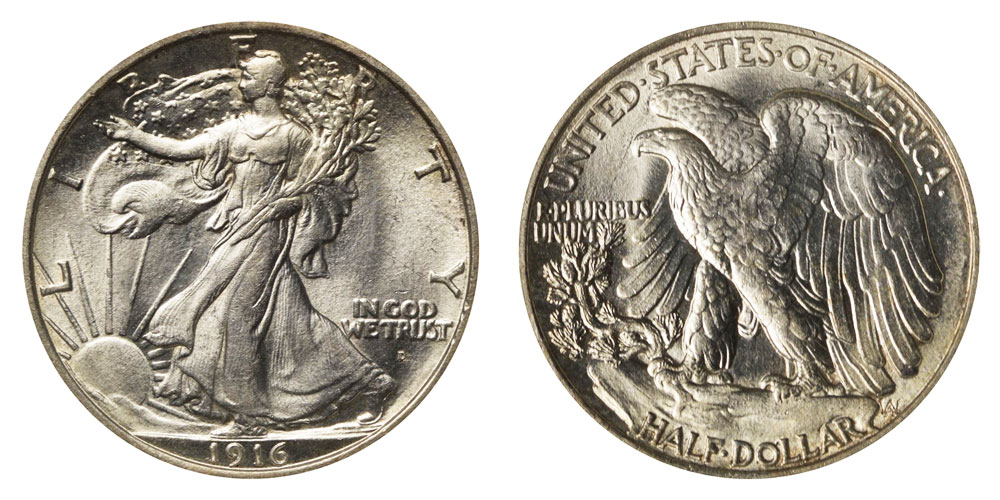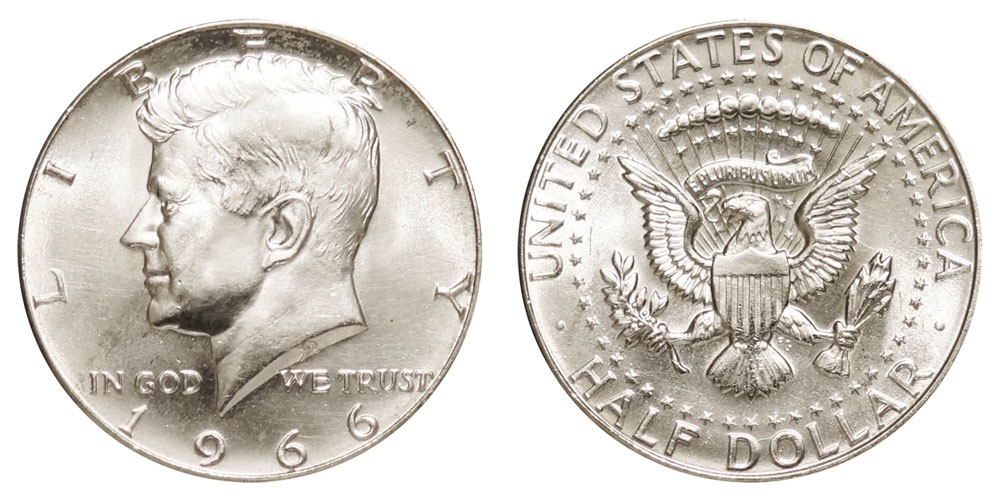Are Half Dollars Valuable? - Silver Half Dollars
The simple answer is most half dollars are only worth their face value: 50 cents.
Older half dollars—any made prior to 1965—were minted from 90% silver. Their intrinsic value, or melt value, is greater than their 50¢ face value. These are the more valuable coins you should be looking for, or holding onto, when you buy silver.

1916 Walking Liberty half dollar
P.S. -- Want to listen to this post?
What Half Dollars Are Silver?
Refer to the following list of U.S. half dollars that are made of silver (Ag), including the date ranges they were minted:
- Walking Liberty half dollar (1916–1947): 90% silver
- Franklin half dollar (1948–1963): 90% silver
- Kennedy half dollar (1964): 90% silver
- Kennedy half (1965–1970): 40% silver
- Kennedy half (1971–date): 0% silver, with the exception of 40% silver for 1976 mint set
Anything older than 1965 will always be 90% silver, although these half dollars also possess quite a lot of collectible appeal (and were minted in rather low numbers).
You can check out a list of half dollar designs—ranging all the way from 1794 to date!

1966 Kennedy half dollar, 40% silver | Image via USA Coin Book
How Much Is My Half Dollar Worth?
In terms of actual silver weight (often abbreviated "ASW"), the 90% silver halves each contain 0.36169 troy ounce of pure silver. That's roughly 11.25 grams of silver content.
The 40% silver half dollars logically have less silver than their predecessors, totaling 0.1479 troy oz per coin, equal to about 4.6 grams ASW.
Most half dollars worth money are going to be made of silver. To figure out how much a given half dollar is worth, follow these simple steps:
- Check the date on the coin. 1964 or earlier means it's 90% silver. 1965 to 1970 means it's 40% silver. (If it's newer than 1970, you're out of luck.)
- Refer to the weights provided above for 90% and 40% silver varieties.
- Multiply the ASW by the current spot price of silver.
How Half Dollars Were Used
Modern half dollars are made from a cheaper copper-nickel "clad" alloy. They are still produced periodically but rarely, if ever, actually circulate as money (i.e., are ever spent as currency).
Half dollar coins were once commonly seen in casinos but are less popular now that most slot machines aren't coin-operated.
Quarters meanwhile became the most convenient and widespread denomination favored by manufacturers of vending machines, arcade chassis, and washers and dryers at laundromats in the late 20th century. This dampened commercial demand for half dollars as a result.

1945-D Walking Liberty Half Dollar (obverse). Image via Wikimedia Commons
Collector interest in today's clad half dollar coins is also minimal. Uncirculated rolls of halves can be requested (or ordered) from any local bank branch in exchange for their face value.
Fun Facts About Half Dollar Coins
- The half dollar denomination was among the first coins ever struck by the United States Mint back in the 1790s.
- Half dollars have long appealed to the public thanks to their relatively large size. All halves minted since 1839 measure precisely 30.6 mm in diameter.
- The John F. Kennedy design created by Gilroy Roberts to commemorate the late president's assassination was so beloved, it has remained the half dollar design for over 50 years. This was similar to the George Washington design on the quarter, which was created by sculptor John Flanagan in 1932 for Washington's 200th birthday but subsequently became a permanent fixture.
- Coin and bullion dealers will typically sell bags of old 90% silver half dollars by face value.
- The artistic merit of Adolph Weinman's Walking Liberty half dollar design is so undeniable that the U.S. Mint repurposed it for the modern American Silver Eagle coins (1986–date).
Read more about silver coins from the experts at Gainesville Coins:
How to Buy Silver Coins: Step-by-Step Guide
How Much Is A Silver Dollar Worth?

Everett Millman
Everett has been the head content writer and market analyst at Gainesville Coins since 2013. He has a background in History and is deeply interested in how gold and silver have historically fit into the financial system.
In addition to blogging, Everett's work has been featured in Reuters, CNN Business, Bloomberg Radio, TD Ameritrade Network, CoinWeek, and has been referenced by the Washington Post.
